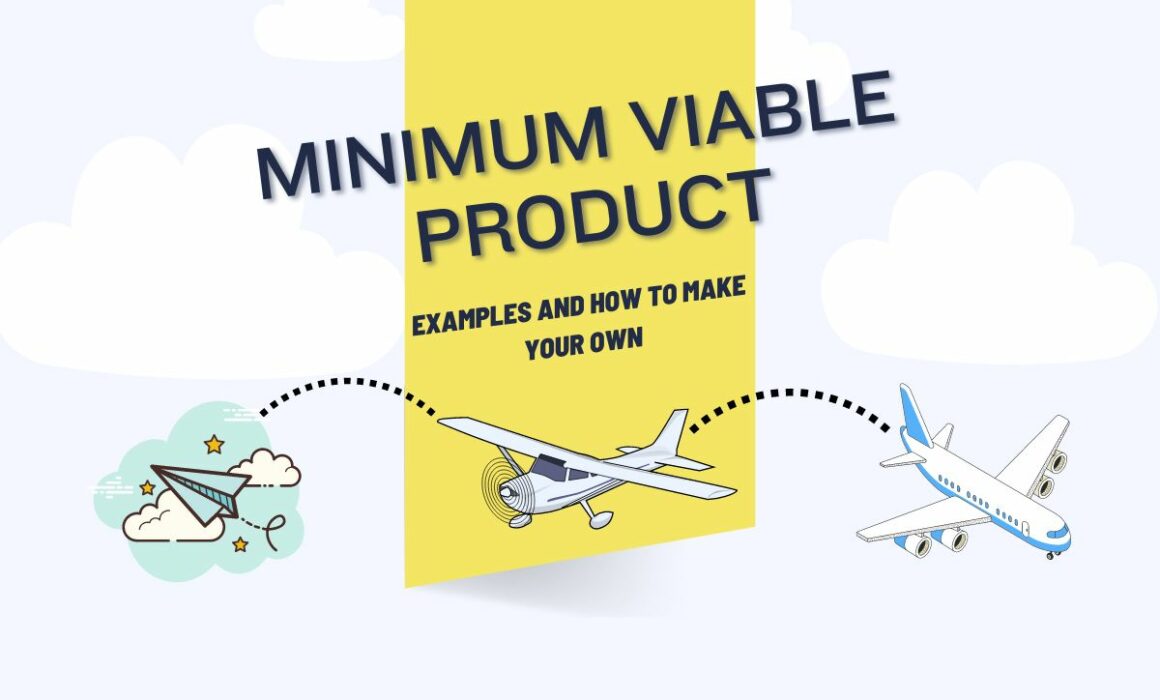What Is The Product Backlog Refinement Process in Scrum?
Product backlog refinement might sound so technical, but it simply transforms your raw ideas into clear and structured ones.
Backlog refinement is an important part of the Agile and Scrum software development methodologies. According to the Scrum Guide, refinement is the process of breaking down and providing more specific details to product backlog items, making them smaller and more specific.
According to the 15th Annual State of Agile Report, 66% of Agile organisations identified Scrum as the most popular and closely followed Agile approach. And 83% of them considered backlog refinement a vital practice.
But why is this process important? Because the result is a well-prepared, prioritised, and understood backlog. This process also promotes collaboration, adaptability, and efficiency, which lead to a more successful product development process.
In this article, you’ll learn about the key activities in this process, the people involved, its frequency, and its benefits. You’ll also learn about the challenges of developing strategies and solutions in advance.
Table of Contents
- What is product backlog refinement?
- What is the key activity of product backlog refinement?
- Who is involved in product backlog refinement?
- How often should you refine your backlog: daily, weekly, or once per sprint?
- What are the benefits of a backlog refinement meeting?
- Update the product backlog
- Discuss requirements during refinement sessions to generate new ideas and innovations
- Identify dependencies and risks early on during refinement sessions
- Break down user stories into smaller, more manageable tasks
- Improve the accuracy of estimates and reduce the risk of incomplete or poorly defined requirements
- Challenges in product backlog refinement
- Conclusion
- Machine Learning In Finance: 12 Essential Applications
- How To Create Interactive Compliance Training For Bank Employees
- How Fintech Apps Are Using Gamification To Increase User Engagement
- Top Gamification Companies for Employee & Customer Engagement
What is product backlog refinement?
Product backlog refinement was formerly known as “backlog grooming”. It involves reviewing, clarifying, and preparing the product backlog for implementation. But before we go deeper into the product backlog focused on refinement, you should know that product backlog refinement is different from sprint backlog or backlog grooming.
The product backlog refinement is a well-structured inventory of all the necessary tasks to construct a digital product.
Product backlog refinement is an ongoing activity that involves adding details like clear descriptions, the order of actions, and the size or scale of the task.
It helps the team to have a well-prepared backlog that accurately represents the product vision. It also facilitates effective sprint planning meetings and enables smoother implementation during the next and upcoming sprints.
The main objective of product backlog refinement is?
The main objectives of the product backlog are to understand each backlog item. Doing a product backlog refinement is what helps estimate the total effort required to split complex tasks and provides prioritisation during the ongoing process.
Furthermore, the backlog refinement process identifies dependencies and updates the descriptions, user stories, and criteria of backlog items.
Capacity planning tools can aid in product backlog refinement by providing data on the team’s efficiency, resource availability, and capacity constraints. This information assists in making informed decisions about the prioritisation and sequencing of product backlog during refinement sessions.
The flowchart below shows that the product owner, product manager, and stakeholders will have many conversations before adding the item to the product backlog. The stakeholder must develop a better idea if the idea is not considered valuable. A product backlog item usually undergoes three refinement sessions before it is ready.
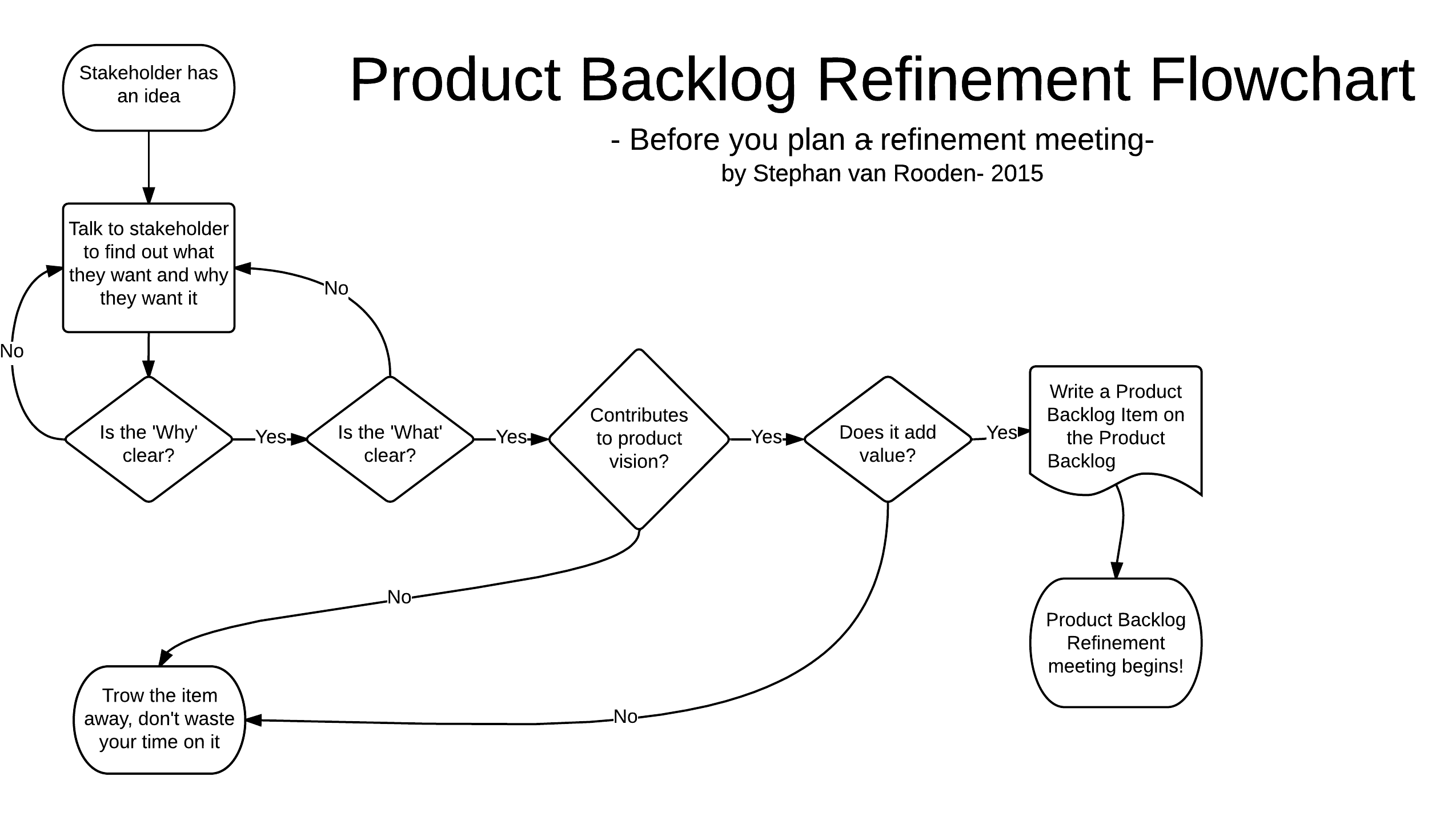
Source: Scrum.org
What is the purpose of product backlog refinement?
It is all about collaboration and alignment, ensuring all stakeholders are on the same page. They must have a shared understanding of the product vision, goals, and upcoming work.
Many product managers are using this process to improve their products. For instance, Spotify has implemented product backlog refinement to prioritise their most valuable features. It leads to a better user experience and increased customer satisfaction.
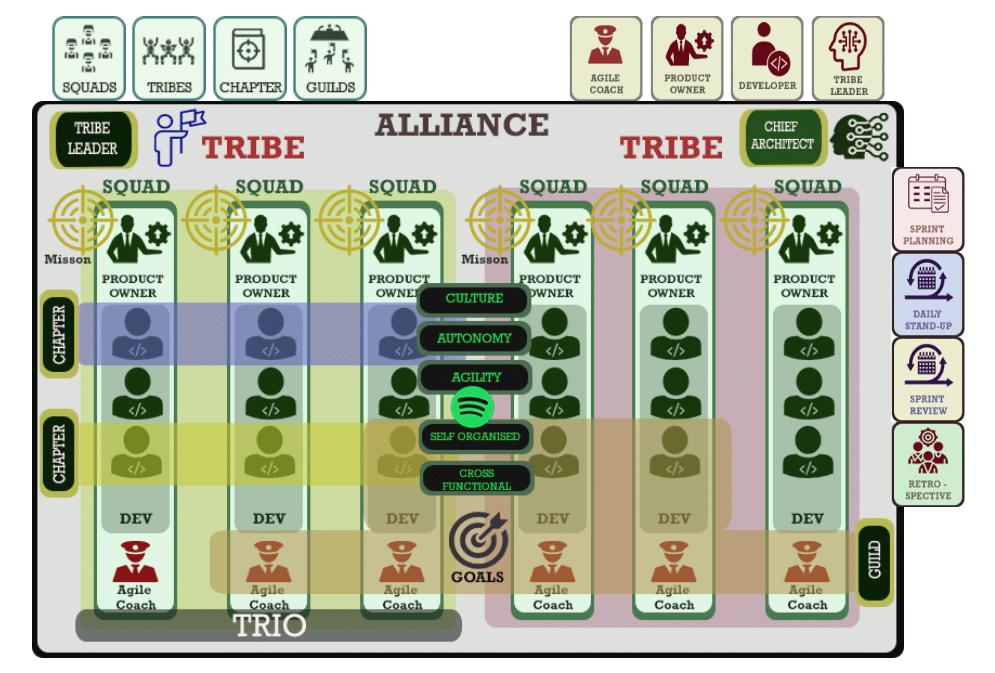
Source: Agile Frameworks
Microsoft has also embraced backlog refinement across various product teams. They refine their backlogs regularly and continuously to ensure that development efforts are focused on delivering the most valuable features. Additionally, it makes sure that they successfully meet customer needs.
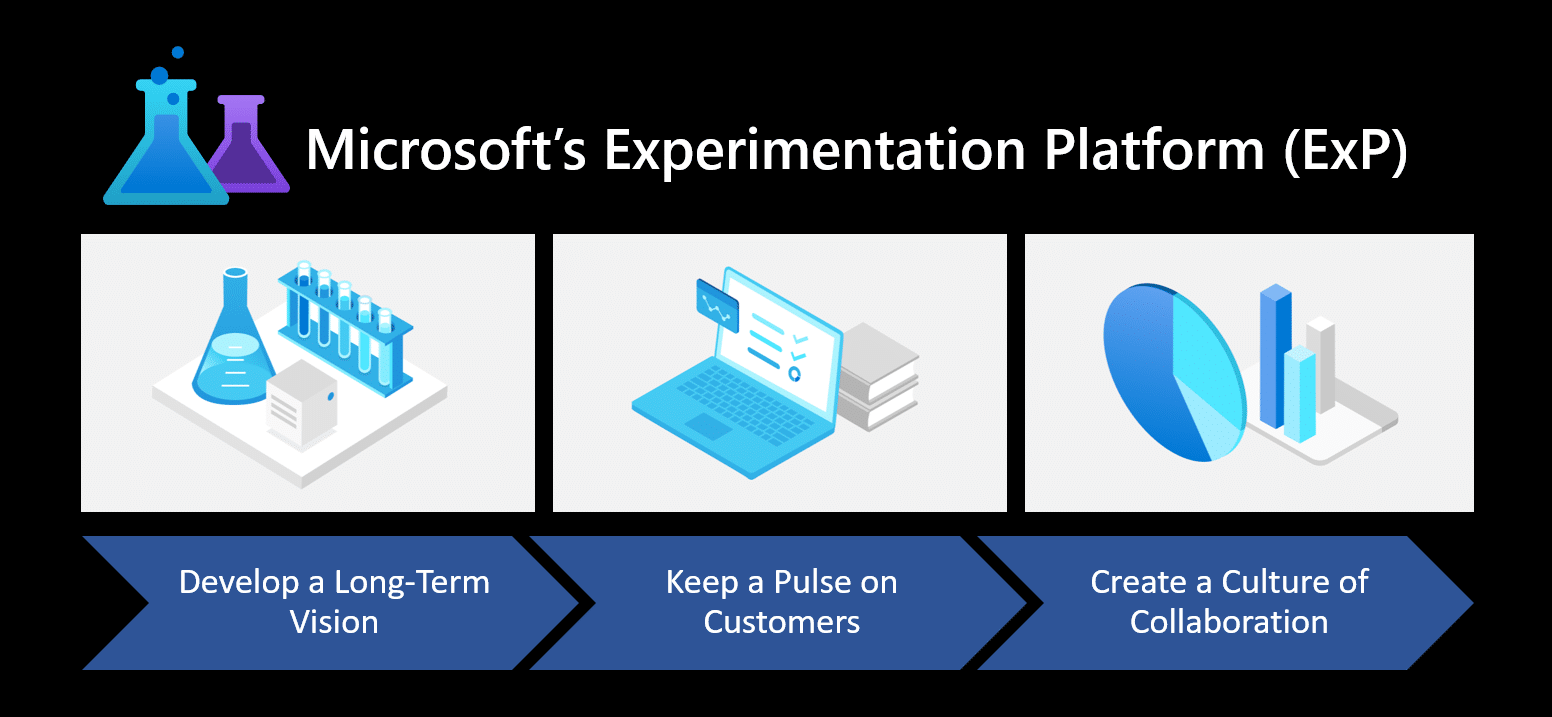
Source: Microsoft
What is the key activity of product backlog refinement?

Source: Innolution
The main activity of product backlog refinement is the collaborative review and enhancement of the various product backlog items. This involves the development team members collaborating on several important tasks and discussions. The key activities during product backlog refinement meetings include:
#1. Reviewing and prioritising
The product owner and the development team collaborate to review the items in the product backlog. They assess the priority of each item based on factors such as user value, business objectives, market demands, and stakeholder feedback.
The team may provide input on the priority based on their technical understanding and dependencies.
#2. Clarifying and defining
The team engages in discussions with the product owner to clearly understand each backlog item. They collaborate with the product owner and stakeholders to clarify the item’s requirements, acceptance criteria, and specific details.
#3. Estimating effort
The team members provide effort estimates for each backlog item. These estimates help in understanding the relative complexity or size of the item.
Common estimation techniques include story points, t-shirt sizing, or other relative sizing methods. Estimation assists in capacity planning, sprint planning, and forecasting the timeline for implementation.
#4. Breaking down and refining
If a backlog item is too large or complex to be completed within a single sprint, the team may break it down into smaller, more manageable sub-items or tasks.
This allows for more accurate estimation and planning. The team members collaboratively refine the sub-items’ descriptions, requirements, and acceptance criteria as needed.
#5. Identifying risks and dependencies
During product backlog refinement, the team identifies any dependencies between backlog items or with external factors. This includes examining technical dependencies, cross-functional dependencies, and any potential risks related to the items.
Identifying dependencies and risks allows the team to plan and manage them effectively.
#6. Updating prioritisation and details
The team may update the priority of backlog items based on new insights or changing circumstances. They can also edit the descriptions, user stories, or acceptance criteria to improve clarity and alignment with the latest requirements.
These updates ensure the backlog accurately represents the product’s needs and goals.
Who is involved in product backlog refinement?
Product backlog refinement involves the active participation of key players – the Product Owner, the Scrum Master, and the Development Team. The collaboration of these players promotes shared understanding, transparency, and effective decision-making throughout the product development process.
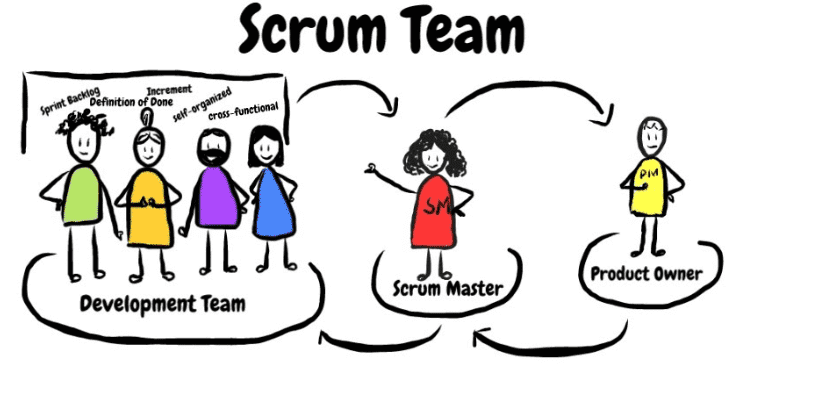
Source: Letsscrumit
#1. Product owner
The product owners are responsible for managing and defining product backlog items. They ensure that the product backlog items are refined and ready for implementation.
They actively engage in product backlog item refinement sprint review sessions, provide clarifications, add details and make decisions regarding priority and scope.
#2. The development team
The development team comprises individuals responsible for implementing the product backlog items. They actively participate by providing input on technical feasibility, effort estimation, and dependencies.
The team collaborates with the product owners to understand the backlog items clearly, seek clarifications, and suggest refinements.
#3. The scrum master and scrum team
The entire scrum team and scrum master facilitate the refinement process by ensuring that the sessions are conducted effectively and that the whole scrum team’s principles and practices are followed.
The scrum teams help organise the sessions, foster collaboration, and ensure that the refinement activities align with the whole scrum team’s goals and objectives.
Take note the involvement level of many teams depends on the size and complexity of the project. In some cases, other specialists should participate in providing expertise in specific areas.
How often should you refine your backlog: daily, weekly, or once per sprint?
While there is no one-size-fits-all answer, the key here is to balance keeping the backlog refined and up-to-date. Ensuring the refinement activities are sufficient for the team’s ability to deliver value in each sprint.
The frequency and duration of the process may vary based on the team’s needs and the product’s complexity.
- Daily refinement sessions are recommended for teams that have just started implementing Agile. According to the Scrum Guide, daily refinement builds a habit of regularly improving the backlog.It also helps familiarise the team with the backlog items during future sprints.
- Weekly sessions allow the team to consolidate the tasks completed in a week. They can then assess and prioritise backlog items. Weekly refinement also allows active engagement with the backlog during a sprint.
- It is common for teams to schedule product backlog refinement sessions once per sprint, typically towards the end of the current sprint. This allows the team to prepare the backlog items for the upcoming sprint. Once per sprint session, ensures that the highest-priority things are sufficiently refined.
How to run a product backlog refinement session effectively?
The Scum Master is the leading player here.
An effective product backlog refinement session ensures productive discussions, shared understanding, and actionable outcomes.
Here are some tips to help you run a successful backlog refinement session:
-
Prepare in advance
As the facilitator, ensure that you are well-prepared for the session. Review the backlog items and gather any necessary information or context beforehand. Identify any specific items or areas that require attention during the session.
-
Establish objectives
Communicate the purpose and objectives of the sprint goal of the session to all participants. Outline what you aim to achieve, whether it’s clarifying backlog items, estimating effort for specific items, splitting items, or updating priorities.
Communicating effectively will help establish the objectives of the sprint planning.
-
Invite the right participants
Invite the Product Owner, Development Team members, and other stakeholders whose input is valuable for the refinement process. Ensure the session includes the necessary expertise and perspectives to address the backlog items effectively.
-
Create agenda
Set a time limit for the session and create an agenda that outlines the topics and activities to be covered. This helps manage time effectively and ensures that all important aspects of sprint planning meetings are addressed. Stick to the agenda and keep the discussion focused.
-
Encourage participation
Encourage active participation among the attendees. Create an inclusive and open environment where everyone feels comfortable sharing their thoughts, concerns, and suggestions.
-
Reach a consensus
Facilitate the decision-making process to reach a consensus on backlog item priorities, effort estimates, and potential refinements. If disagreements arise, work towards resolving them by encouraging open dialogue and seeking alignment.
-
Document action items
Document the session’s outcomes, including any decisions, refinements, or actions needed. Share the results with the team and stakeholders to maintain transparency and accountability.
-
Follow up
After the session, the team discusses follow-up on any action items or next steps. Monitor the progress of the refinements, track any changes made to the backlog items, and ensure that they are reflected accurately.
-
Evaluate and improve
Continuously evaluate and improve your backlog refinement sessions based on feedback and experience. Encourage the team to provide input on how to make the continuous refinement sessions more effective and efficient.
What are the benefits of a backlog refinement meeting?
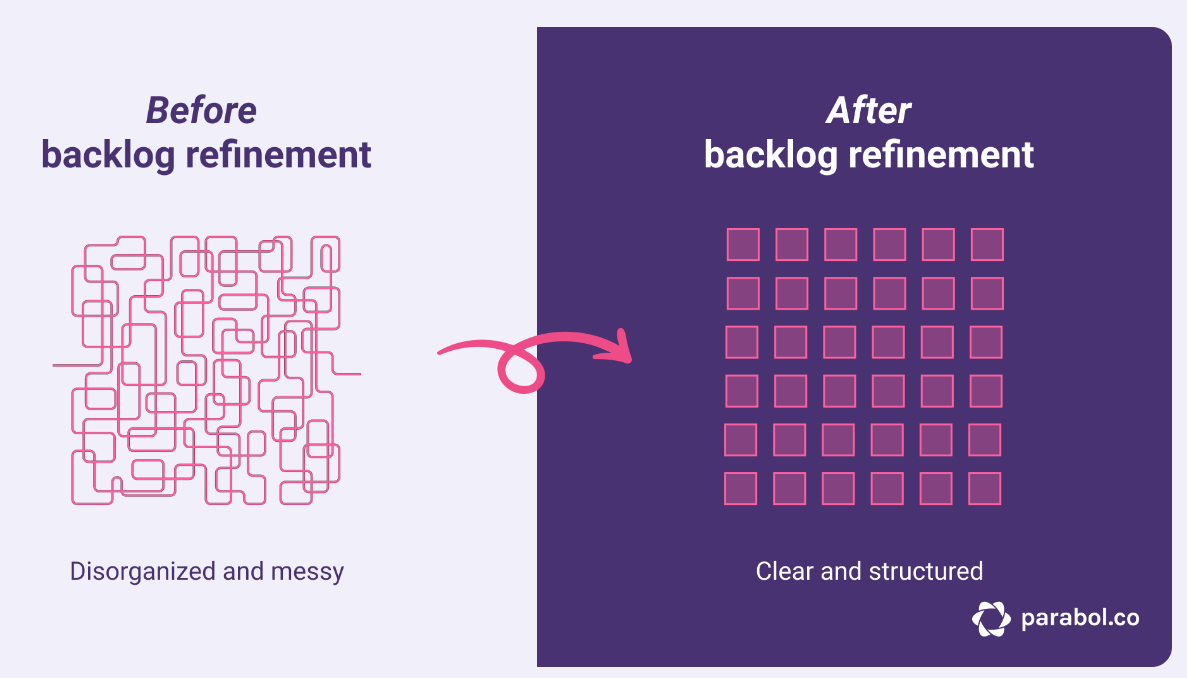
Source: Parabol
A backlog refinement meeting offers several benefits to the Product Owner, the Development Team, and the overall project. Here are the key benefits of conducting the backlog refinement meeting:
Update the product backlog
Backlog refinement is necessary to ensure the product backlog improves over time. As a result of this process, the product backlog gets updated with new information. It has revised estimates, improved item descriptions, and refined priorities.
This becomes a more accurate and valuable tool for product discovery and development.
Discuss requirements during refinement sessions to generate new ideas and innovations
During discussions, the team collaboratively generates new ideas to adapt and respond to changing requirements, market conditions, or customer feedback. They incorporate new information and innovations and make necessary changes.
This allows the product to improve and align with the changing needs of the users and the business.
Identify dependencies and risks early on during refinement sessions
During backlog refinement sessions, the team can identify potential issues, dependencies, or risks associated with the backlog items. Addressing these concerns in advance helps avoid bottlenecks, delays, or disruptions during the early stages of the development process.
Break down user stories into smaller, more manageable tasks
When the backlog items are appropriately sized, the Development Team can start working on them without confusion or delays. This leads to smoother sprint execution, reduced interruptions, and improved overall efficiency.
Improve the accuracy of estimates and reduce the risk of incomplete or poorly defined requirements
Through backlog refinement, the team provides effort estimates for the backlog items. Accurate estimation allows the team to set realistic expectations and allocate resources effectively. Planning sprints in more detail and precise results in improved project planning and delivery.
Challenges in product backlog refinement
Like any other aspect of product development, the refinement process comes with its own challenges.
One of these challenges is managing dependencies between backlog items. Failure to manage dependencies effectively can result in delays, rework, or inconsistent implementation. Also, it can be challenging to accurately estimate the time and resources needed for implementation.
Priorities can also change as the project progresses and based on business needs. This can lead to shifting priorities for backlog items, requiring continuous reassessment and adjustment.
More involvement and feedback from stakeholders can be challenging too. With their input, it may be easier to understand user needs, market trends, or business priorities accurately.
Nevertheless, do not let these difficulties intimidate you. These can be addressed through a proactive and collaborative approach.
Conclusion
Product backlog refinement is not just a process. It takes a mindset to improve continuously. With each refinement session, the product backlog improves, becoming a well-tuned tool that drives efficiency, collaboration, and innovation.
By implementing backlog refinement as a collaborative and iterative process, you can also discover the true potential of your products, delivering business value that surpasses expectations.
If this information interest you and you like to learn more, Mambo.IO is here to assist you. We are dedicated to helping a product manager like you by boosting your products’ value to the end-users. If you have questions, feel free to contact us.
Download your free
“Gamification Guide”
Get your PDF now and start transforming your approach to digital engagement!
Latest Posts
Machine Learning In Finance: 12 Essential Applications
The impact of machine learning on finance is significant. Thanks to this technology, financial institutions are now equipped to make efficient decisions. Through the analysis of data sets, machine learning […]
How To Create Interactive Compliance Training For Bank Employees
Banking compliance training isn’t just another task. It’s the stage where everything else performs. Banks must navigate a myriad of regulations and laws. After all, this is a trust-driven, high-stakes […]
How Fintech Apps Are Using Gamification To Increase User Engagement
Discover how gamification in fintech is revolutionizing financial engagement, making banking fun & boosting user loyalty.







